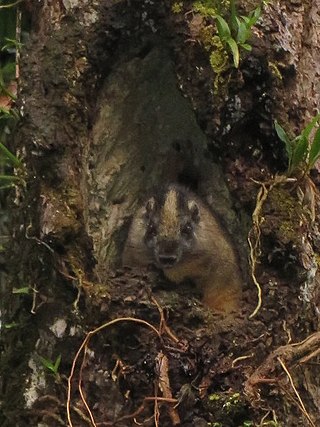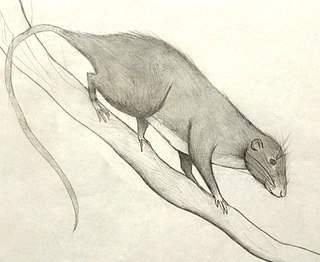Related Research Articles

The painted tree-rat is a species of spiny rat from Brazil, restricted to north-eastern Bahia in eastern Brazil. It is the only species in the genus Callistomys.

The toros or brush-tailed rats, genus Isothrix, are a group of spiny rats found in tropical South America, particularly in the Amazon Basin.
The giant tree-rat is a species in the family Echimyidae, the spiny rats. It is the only species in the monotypic genus Toromys. It is endemic to Brazil, where it occurs in the flooded forest along the banks of the Amazon River and its tributaries.
The tuft-tailed spiny tree rat is a spiny rat species from Brazil south of the Amazon River, where it has been found in grassland and gallery forest. It is the only species in the genus Lonchothrix. Very little is known about this rodent. It is small with an average adult weight of about 138 grams. It is nocturnal and solitary in habits.

The long-tailed spiny rat is a spiny rat species found in Bolivia, Brazil and Paraguay.

Euryoryzomys emmonsae, also known as Emmons' rice rat or Emmons' oryzomys, is a rodent from the Amazon rainforest of Brazil in the genus Euryoryzomys of the family Cricetidae. Initially misidentified as E. macconnelli or E. nitidus, it was formally described in 1998. A rainforest species, it may be scansorial, climbing but also spending time on the ground. It lives only in a limited area south of the Amazon River in the state of Pará, a distribution that is apparently unique among the muroid rodents of the region.

Proechimys is a genus of South American spiny rats of the family Echimyidae. All species of the genus are terrestrial. In the lowland Neotropical forests, Proechimys rodents are often the most abundant non-volant mammals. They are recognizable by reason of their elongated heads and long rostra, large and erect ears, narrow and long hind feet, and tails always shorter than head-and-body lengths. The dorsal pelage comprises a mixture of expanded, varyingly stiffened spines — hence the vernacular name of spiny rats — and soft hairs.
Phyllomys is a genus of arboreal spiny rat, geographically restricted to the forests of eastern Brazil.

Mesomys is a genus of South American spiny rats in the family Echimyidae.

Dactylomys is the genus of South American bamboo rats They are arboreal members of the family Echimyidae.

Olallamys is a genus of Andean soft-furred spiny rat that range from Panama through Colombia and Venezuela to northern Ecuador. These species are typically found at elevations above 2,000 metres (6,600 ft).
Hylaeamys megacephalus, also known as Azara's broad-headed oryzomys or the large-headed rice rat, is a species of rodent in the genus Hylaeamys of family Cricetidae, of which it is the type species. It is found mainly in lowland tropical rainforest from its type locality in Paraguay north through central Brazil, French Guiana, Guyana, Suriname, and Venezuela onto Trinidad and Tobago. To its west and east, other closely related species of Hylaeamys are found: H. perenensis in western Amazonia, H. acritus in Bolivia, and H. laticeps and H. oniscus in the Atlantic Forest of eastern Brazil.

Diplomys is a genus of rodent in the family Echimyidae. They are found in Costa Rica, Ecuador, Colombia and Panama.

The armored rat is a species of rodent in the family Echimyidae. It is monotypic within the genus Hoplomys. It is found in Latin America, from northern Honduras to northwest Ecuador. It possesses a range of spines on its back and sides of the body.
Pattonomys is a genus of rodent in the family Echimyidae, named after American mammalogist James L. Patton. It contains the following species:
Cerradomys scotti, also known as Lindbergh's oryzomys, is a rodent species from South America in the genus Cerradomys. It is terrestrial and is found in the cerrado (savanna) ecozone of south central Brazil, Bolivia and Paraguay. The species is common and appears to tolerate a degree of agricultural habitat modification.
Hylaeamys acritus, formerly Oryzomys acritus, is an oryzomyine rodent of the family Cricetidae. The name is derived from the Greek word ακριτος 'confused, doubtful', because it could easily be confused with species such as H. megacephalus and Euryoryzomys nitidus. It is known only from northeastern Bolivia; its type locality is within Noel Kempff Mercado National Park. The rodent is terrestrial and is found in moist lowland semideciduous forest and savanna. It has olive brown coloration on its back; the cheeks and flanks are amber, and the top of the head is dark. The coat is 9 mm long at the center of the torso. Chest fur between the front legs is thick and 3 to 4 mm long. Abdominal hairs are gray at the base and white at the top.
In anatomy, posterolateral palatal pits are gaps at the sides of the back of the bony palate, near the last molars. Posterolateral palatal pits are present, in various degrees of development, in several members of the rodent family Cricetidae. Many members of the family lack them or have only simple pits, but Arvicolinae and Oryzomyini have more highly developed posterolateral palatal pits. Posterolateral palatal pits are also present in some other rodents, including Glis, Jaculus, Hystrix, Abrocoma, Ctenomys, Chinchilla, and Lagidium.

James Lloyd Patton, is an American evolutionary biologist and mammalogist. He is emeritus professor of integrative biology and curator of mammals at the Museum of Vertebrate Zoology, UC Berkeley and has made extensive contributions to the systematics and biogeography of several vertebrate taxa, especially small mammals.

Echimyini is a tribe of echimyid rodents, proposed in 2016, and containing 13 extant genera: all of the tree rats Echimys, Phyllomys, Makalata, Pattonomys, Toromys, Diplomys, Santamartamys, and Isothrix, the long recognized dactylomines Dactylomys, Olallamys, and Kannabateomys, and the enigmatic and previously classified as eumysopines Lonchothrix and Mesomys. All these spiny rats genera are arboreal. Worth of note, the arboreal genus Callistomys – the painted-tree rat – does not belong to the tribe Echimyini. Because it is phylogenetically closer to Myocastor, Hoplomys, Proechimys, and Thrichomys than to the above-mentioned Echimyini genera, it is classified in the tribe Myocastorini.
References
- 1 2 Emmons, Louise H.; Feer, François (1990). Neotropical rainforest mammals. A field guide (1st ed.). Chicago: University of Chicago Press. p. 281. ISBN 0-226-20716-1.
- 1 2 Emmons, Louise H.; Feer, François (1997-09-02). Neotropical rainforest mammals. A field guide (2nd ed.). Chicago: University of Chicago Press. p. 307. ISBN 978-0-226-20721-6. OCLC 44179508.
- ↑ "Ecology and behavior of African rainforest squirrels - Cornell University Library Catalog". newcatalog.library.cornell.edu. Retrieved 2021-03-25.
- ↑ Emmons, Louise H.; Vucetich, María Guiomar (1998). "The identity of Winge's Lasiuromys villosus and the description of a new genus of echimyid rodent (Rodentia, Echimyidae)". American Museum Novitates (3223): 1–12. hdl:2246/3503.
- ↑ Emmons, Louise Hickock (2005). "A revision of the genera of arboreal Echimyidae (Rodentia: Echimyidae, Echimyinae), with descriptions of two new genera". Mammalian Diversification: From Chromosomes to phylogeography (A Celebration of the Career of James L. Patton). Vol. 133. University of California Press. pp. 247–310. ISBN 9780520098534.
- ↑ Emmons, Louise H. (1999). "A new genus and species of abrocomid rodent from Peru (Rodentia, Abrocomidae)". American Museum Novitates (3279): 1–14. hdl:2246/3027.
- ↑ Emmons, Louise H.; Leite, Yuri L. R.; Kock, Dieter; Costa, Leonora P. (2002-08-01). "A Review of the Named Forms of Phyllomys (Rodentia: Echimyidae) with the Description of a New Species from Coastal Brazil". American Museum Novitates (380): 1–40. doi:10.1206/0003-0082(2002)380<0001:AROTNF>2.0.CO;2. ISSN 0003-0082. S2CID 56309113.
- ↑ Emmons, Louise H.; Patton, James L. (2005). "A new species of Oryzomys (Rodentia, Muridae) from eastern Bolivia". American Museum Novitates (3478): 1–27. doi:10.1206/0003-0082(2005)478[0001:ANSOOR]2.0.CO;2. hdl: 2246/5669 . S2CID 55366906.
- ↑ Carleton, Michael D.; Emmons, Louise H.; Musser, Guy G. (2009). "A new species of the rodent genus Oecomys (Cricetidae, Sigmodontinae, Oryzomyini) from eastern Bolivia, with emended definitions of O. concolor (Wagner) and O. mamorae (Thomas)". American Museum Novitates (3661): 1–32. doi:10.1206/612.1. hdl:2246/5984. S2CID 85788843.
- ↑ Emmons, Louise H. (1993). "A new genus and species of rat from Borneo (Rodentia : Muridae)". Proceedings of the Biological Society of Washington. 106 (4): 752–761. ISSN 0006-324X.
- ↑ Solari, Sergio; Pacheco, Víctor; Vivar, Elena; Emmons, Louise H. (2012-10-01). "A new species of Monodelphis (Mammalia: Didelphimorphia: Didelphidae) from the montane forests of central Perú". Proceedings of the Biological Society of Washington. 125 (3): 295–307. doi:10.2988/11-33.1. ISSN 0006-324X. S2CID 85588030.
- ↑ Emmons, L. H. (1988-05-20). "Replacement Name for a Genus of South American Rodent (Echimyidae)". Journal of Mammalogy. 69 (2): 421. doi:10.2307/1381405. ISSN 0022-2372. JSTOR 1381405.
- ↑ Musser, Guy G.; Carleton, Michael D.; Brothers, Eric M.; Gardner, Alfred L. (1998). "Systematic studies of oryzomyine rodents (Muridae, Sigmodontinae) : diagnoses and distributions of species formerly assigned to Oryzomys capito". Bulletin of the AMNH. 236: 233–239. hdl:2246/1630.
- ↑ Beolens, Bo; Watkins, Michael; Grayson, Michael (2009-10-07). The Eponym Dictionary of Mammals. JHU Press. p. 127. ISBN 9780801895333.
- ↑ Verzi, Diego H.; Vucetich, M. G.; Montalvo, C. I. (1995). Un nuevo Eumysopinae (Rodentia, Echimyidae) del Mioceno tardío de la Provincia de La Pampa y consideraciones sobre la historia de la subfamilia. Ameghiniana 32: 191–95.